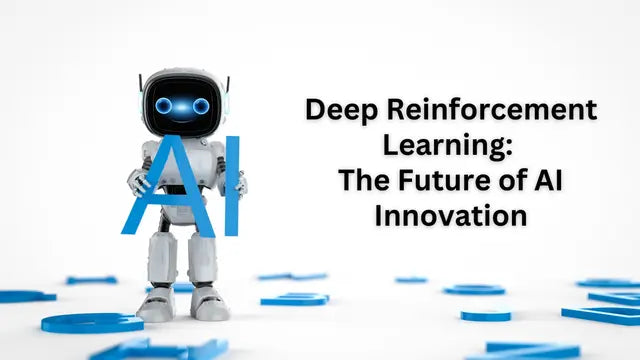
Deep Reinforcement Learning: The Future of AI Innovation
Share
In the ever-evolving world of artificial intelligence (AI), deep reinforcement learning (DRL) is pushing the boundaries of what machines can achieve. By combining the trial-and-error methodology of reinforcement learning (RL) with the pattern-recognition power of deep learning (DL), DRL equips machines with the ability to tackle complex tasks autonomously. Whether it's mastering strategy games or advancing healthcare, DRL is transforming industries and redefining AI capabilities.
What is Deep Reinforcement Learning?
Deep reinforcement learning is a subfield of machine learning where an agent learns to make decisions by interacting with its environment. The goal is to maximize cumulative rewards over time, all while learning from trial and error. What sets DRL apart is its use of neural networks, which enable the agent to interpret high-dimensional inputs like images, text, or real-world scenarios.
Key Components of DRL:
* Agent: The decision-maker responsible for taking actions.
* Environment: The system the agent interacts with, which provides feedback.
* Reward System: The guiding force behind the agent's actions, offering positive or negative feedback to reinforce learning.
For example, consider training a robotic arm to stack blocks. The environment is the workspace, the agent is the robotic arm, and the reward system ensures positive feedback for successfully stacked blocks and negative feedback for failed attempts. Over time, the agent learns the optimal strategy through experience.
How Does DRL Work?
At its core, DRL revolves around continuous learning and improvement
1. Interaction:
The agent interacts with the environment by taking actions.
2. Feedback:
Based on the action, the environment provides a reward or penalty.
3. Learning:
Using neural networks, the agent processes high-dimensional inputs (e.g., images from a camera) and adjusts its strategy to maximize rewards.
One famous DRL example is DeepMind's AlphaGo, which defeated world champions in the game of Go. By using deep neural networks and RL, AlphaGo analyzed millions of moves, refined its decision-making process, and outperformed human players.
Applications of Deep Reinforcement Learning
Deep reinforcement learning isn't just about flashy AI achievements; it has practical applications across a range of industries
1. Gaming:
DRL has revolutionized gaming by creating AI that can master strategy-based and real-time games
* Chess and Go: AI programs like AlphaZero dominate these classic games.
* StarCraft II: DRL agents analyze complex strategies, beating top human players.
2. Robotics:
DRL enables robots to perform intricate tasks autonomously
* Assembly Tasks: Robots in factories learn to assemble products with precision.
* Navigation: Drones and autonomous vehicles use DRL to navigate obstacles in real-time.
3. Healthcare:
The healthcare industry benefits immensely from DRL's decision-making abilities
* Treatment Optimization: AI tailors treatment plans for individual patients.
* Resource Allocation: Hospitals optimize staff schedules and equipment usage during emergencies.
4. Finance:
DRL is also making waves in the finance sector:
* Portfolio optimization.
* High-frequency trading strategies.
Python Libraries for Deep Reinforcement Learning
Getting started with DRL is easier than ever, thanks to Python’s robust ecosystem of libraries. Here are some essential tools
1. Stable-Baselines3:
* A user-friendly library for implementing popular RL algorithms.
* Ideal for beginners due to its simple API.
2. TensorFlow and PyTorch:
* These deep learning frameworks are invaluable for building and training neural networks used in DRL.
* TensorFlow is often preferred for large-scale production, while PyTorch is praised for its ease of use.
3. OpenAI Gym:
* A toolkit for developing and testing RL algorithms in simulated environments.
* Offers a variety of tasks, from simple cart-pole balancing to complex robotics simulations.
The Future of DRL
Deep reinforcement learning is set to revolutionize even more industries in the coming years. As research advances, DRL will become more efficient, scalable, and adaptable. Potential future applications include
* Personalized Education: Tailoring learning experiences for students.
* Smart Cities: Optimizing traffic flow and energy usage.
* Space Exploration: Equipping AI-powered robots to navigate and explore distant planets.
Tips for Getting Started
* Start Small: Begin with simple RL problems like balancing a cart-pole using OpenAI Gym.
* Leverage Online Resources: Platforms like Coursera and Udemy offer beginner-friendly DRL courses.
* Experiment with Libraries: Try out Stable-Baselines3 and combine it with TensorFlow or PyTorch.
* Engage with the Community: Join forums like Reddit’s r/MachineLearning or participate in Kaggle competitions.
Final Thoughts
Deep reinforcement learning represents a monumental leap in AI capabilities. By combining the exploratory power of reinforcement learning with the adaptability of deep learning, DRL enables machines to learn, adapt, and excel in ways that were once thought impossible.
With Python lowering the entry barriers to this exciting field, there has never been a better time to explore the possibilities of DRL. Whether you're a curious beginner or an AI enthusiast, the world of deep reinforcement learning is ready for you to dive in.
So, are you ready to reshape the future of AI?
